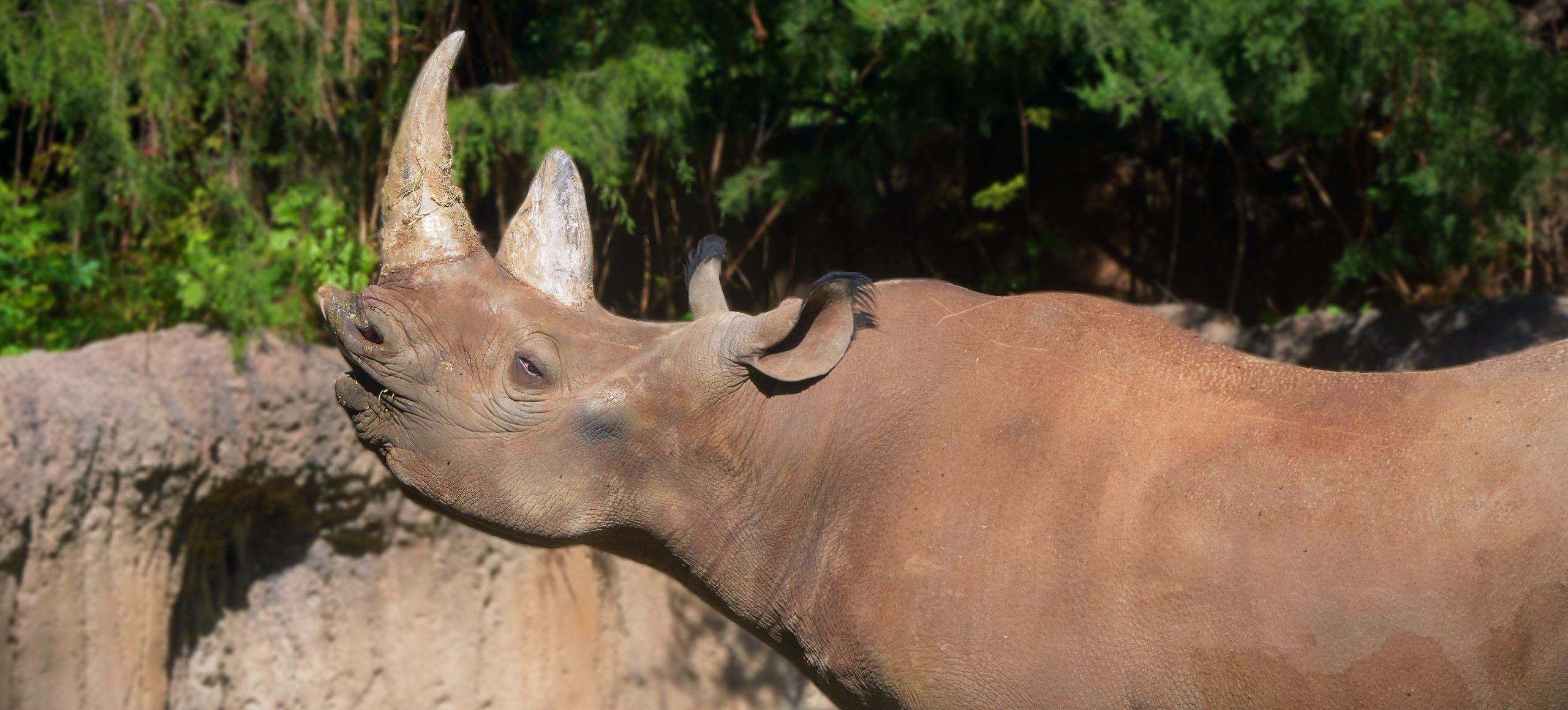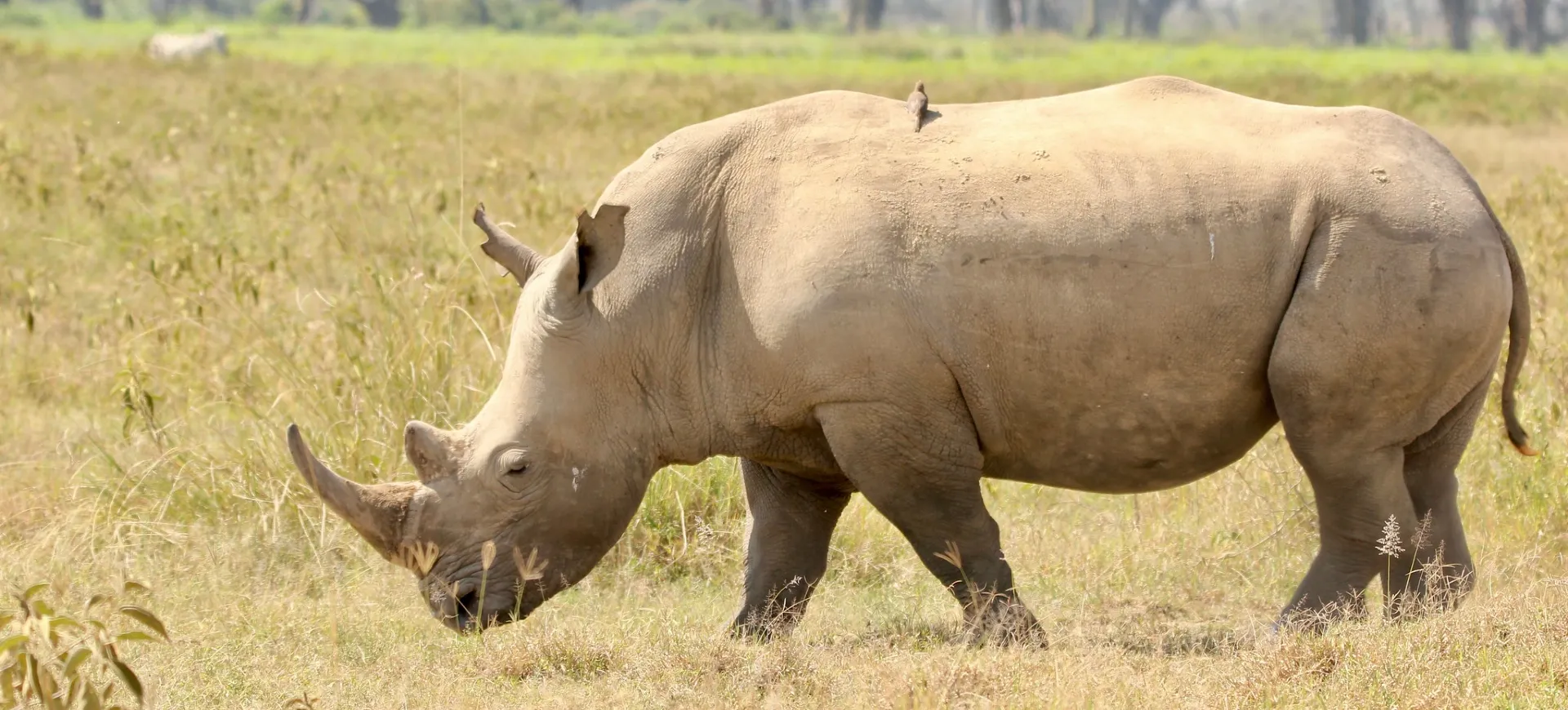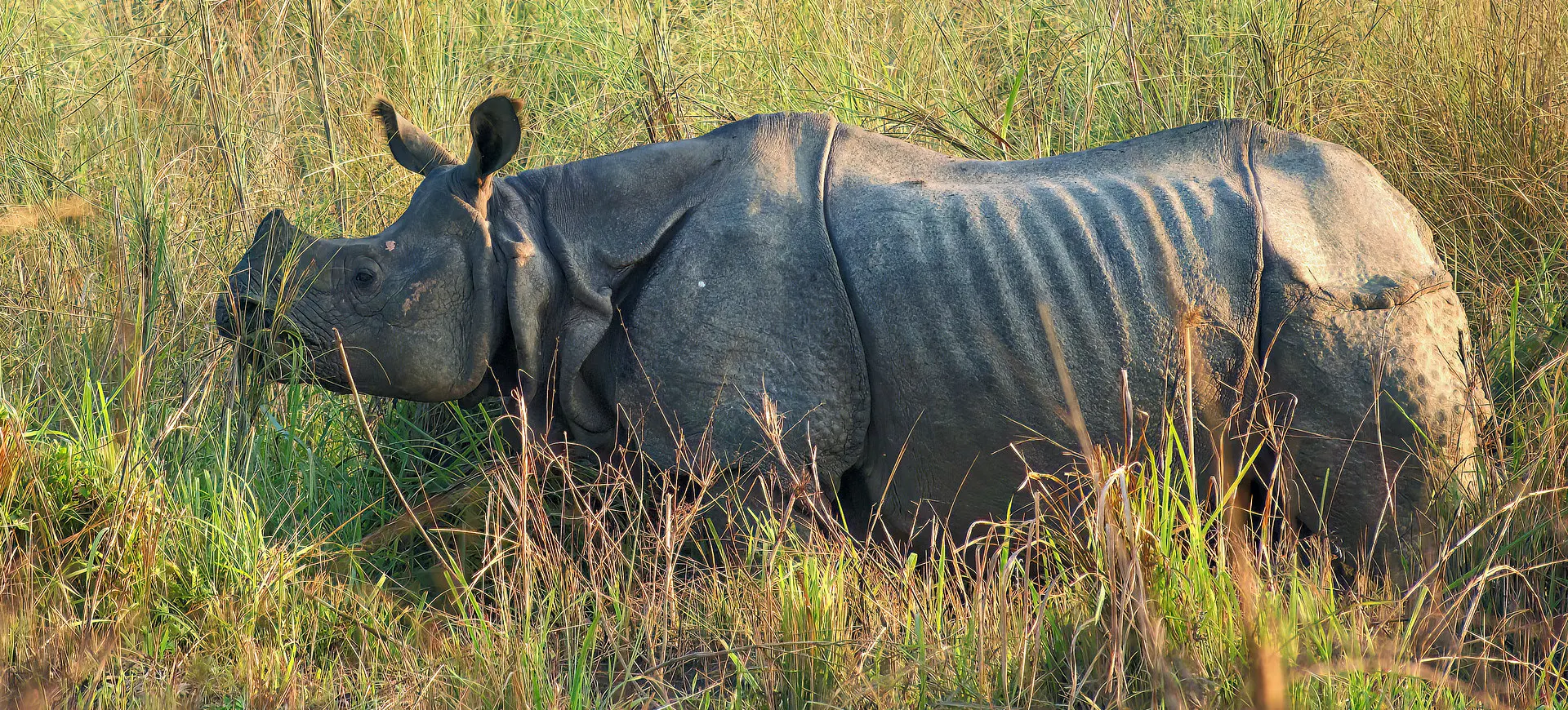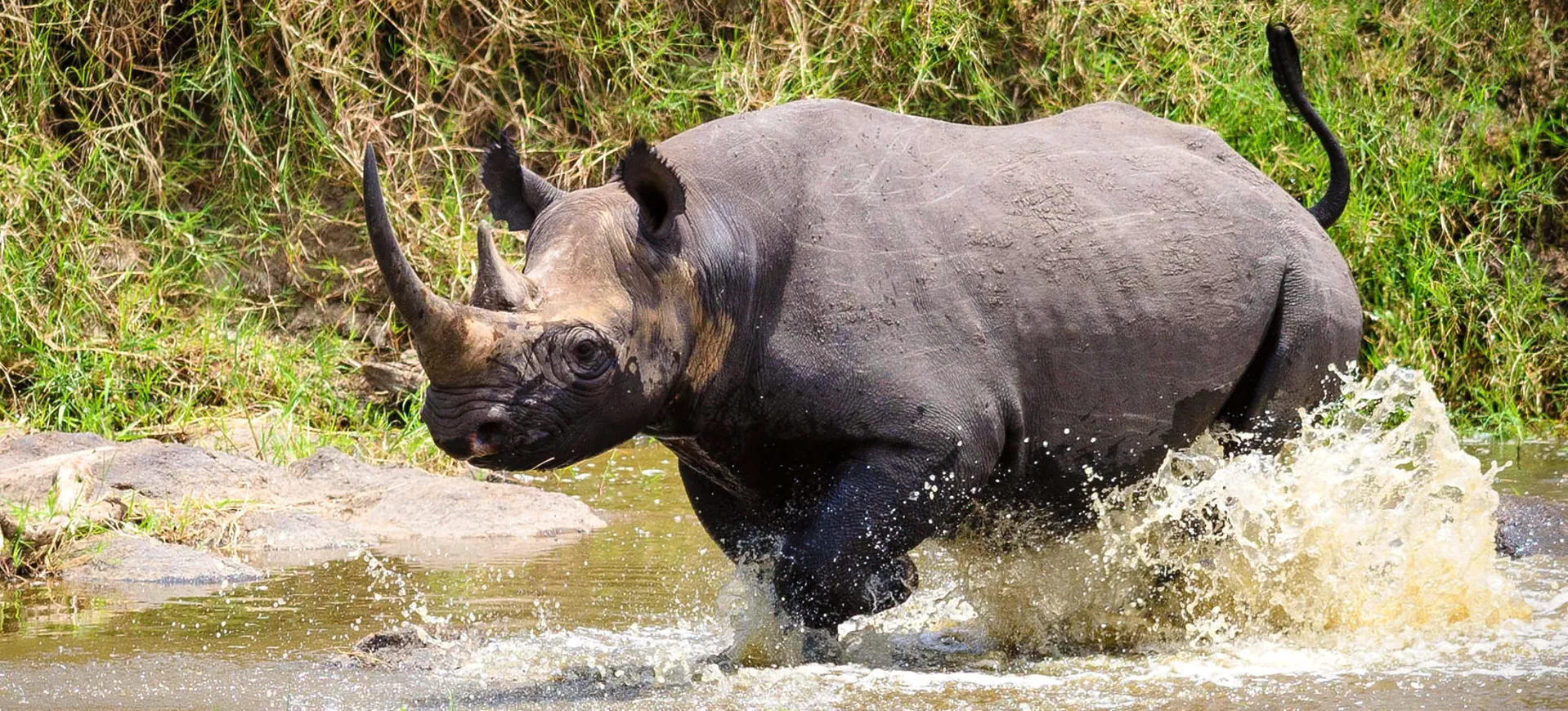Overview
The Eastern Black Rhinoceros, also known as the East African Black Rhinoceros, is a subspecies of the black rhinoceros and an iconic symbol of the African wild. Characterized by its impressive size and two distinctive horns made of keratin, the same material found in human hair and nails, it is one of the largest rhino species in existence. The Eastern Black Rhino is known for its temperamental and unpredictable nature, which, coupled with its formidable size, makes it one of Africa’s most respected and feared animals.
Primarily a solitary creature, the Eastern Black Rhino is most active during the night and early morning, spending the daytime hours resting and avoiding the heat. These rhinos have poor vision but compensate for this with an excellent sense of smell and hearing. With a herbivorous diet that mainly consists of leaves, twigs, and shoots, the Eastern Black Rhino plays a significant role in shaping the African landscape by aiding in the regeneration of plant life.
Unfortunately, the Eastern Black Rhino is severely threatened by poaching and habitat loss, primarily due to human activities. Despite various conservation efforts to protect and increase its population, the species is still classified as Critically Endangered, with a decreasing population trend. Today, they are found in reserves in Kenya, Tanzania, and Rwanda, and their future is dependent on the continued efforts of conservation organizations and governments worldwide.
Taxonomy
Kingdom
Phylum
Class
Order
Family
Genus
Species
Sub Species
Type
Physical Description:
The Eastern Black Rhinoceros is a large, robust creature with thick, protective skin that varies from brown to gray. The most distinctive feature of this rhinoceros is its two horns, with the front horn larger than the rear, reaching lengths of up to 55 inches. They are not actual horns but are instead made of keratin fibers, compacted and arranged in a growth pattern. The black rhino also has a distinctive pointed, prehensile upper lip which it uses to grasp leaves and twigs when feeding.
Their body is bulky and barrel-shaped, with a broad chest and powerful legs, each ending in three toes tipped with large nails. Adults stand about 4.5 to 6 feet at shoulder height and can reach lengths of up to 12.5 feet, excluding the tail, which adds 28 inches to the overall length. They have a small tail, often seen with a tuft at the end. Their heads are massive and held lower to the ground than other rhinos, partly due to the animal’s browsing feeding habits.

Lifespan: Wild: ~35 Years || Captivity: ~50 Years

Weight: Male: 2200-3000 lbs (1000-1360 kg) || Female: 1760-2640 lbs (800-1200 kg)

Length: Male: 11-12.5 feet (3.4-3.8 meters) || Female: 10-12 feet (3-3.6 meters)

Height: Male: 5-6 feet (1.5-1.8 meters) || Female: 4.5-5.5 feet (1.4-1.7 meters)

Top Speed: 34 mph (55 km/h)
Characteristic:
Native Habitat:
The Eastern Black Rhinoceros is native to the grasslands, savannahs, and tropical bushlands of East Africa. Their habitat includes trees, bushes, and open spaces, providing food and cover. Despite their size, these rhinos are adept at navigating dense vegetation. Black rhinos are also found near water sources, as they need to drink at least once every few days and prefer to wallow in mud to cool off and get rid of parasites.
Over time, the Eastern Black Rhino’s habitat has been severely reduced due to human activities. This includes agricultural development, logging, and urbanization, which have led to habitat fragmentation. In particular, the loss of acacia, an important food source, has hurt the species. Today, most Eastern Black Rhinos are found in protected areas, including national parks and reserves.
Climate Zones:
Biomes:
Biogeographical Realms:
Continents:
Diet:
Diet & Feeding Habits:
The Eastern Black Rhino is a browsing herbivore, meaning it feeds mainly on trees, bushes, and shrubs rather than grass. It uses its pointed lip to pluck leaves, buds, and shoots from trees and bushes. With a preference for acacia, a type of tree common in its habitat, it also consumes fruits, berries, and succulent plants when available. This diet varies seasonally, depending on the availability of food.
Despite having a large body, the Eastern Black Rhino has a relatively small stomach and cannot consume large amounts of food at once. Therefore, it spends much of its day feeding, taking advantage of more relaxed night and early morning temperatures. They can survive without water for four or five days but prefer drinking every day when available.
Mating Behavior:
Mating Description:
Eastern Black Rhinos are solitary animals except during mating or when a mother cares for her young. Males, known as bulls, are territorial and mark their territories using dung piles. They are also known to fight fiercely for the right to mate with a receptive female, a cow. During the mating season, the males follow the females closely, often engaging in intense fights with rivals.
Females reach sexual maturity at around five to seven years, while males mature at around seven to ten. Once pregnant, the female will carry the calf for approximately 15 to 16 months. Eastern Black Rhinos are viviparous, meaning the young are born alive, usually as a single calf. The calf will stay with the mother for 2-3 years before leaving alone.
Reproduction Season:
Birth Type:
Pregnancy Duration:
Female Name:
Male Name:
Baby Name:
Social Structure Description:
Eastern Black Rhinos are generally solitary animals, except for mothers and their calves. Adult males are territorial and maintain their territories by marking with dung piles and urine spraying. They defend their territories vigorously from other males.
Females, on the other hand, have overlapping home ranges that are usually extensive. Females with calves have smaller home ranges and have been observed to occasionally form small groups, especially when calves are of similar ages.
Groups:
Conservation Status:
Population Trend:
The Eastern Black Rhino once roamed most of East Africa, but the population has dramatically decreased over the past century. The significant decline is primarily due to rampant poaching driven by the demand for rhino horn in illegal markets. The horn, highly valued in traditional Asian medicine, despite having no proven medicinal value and for ornamental purposes, has led to the aggressive hunting of these majestic creatures.
Habitat loss is another critical factor contributing to the decline. As human populations grow and expand, the rhino’s habitat is converted into agricultural land, impacting their ability to find food and space. The current wild population is fragmented and mainly restricted to reserves and national parks in Kenya, Tanzania, and Rwanda, where efforts are being made to protect the species from further decline.
Population Threats:
Poaching for its horn is the most significant threat to the Eastern Black Rhinoceros. Despite international trade in rhino horns being banned under the Convention on International Trade in Endangered Species (CITES), a thriving black market exists, particularly in Asia, where the horns are highly valued.
Habitat loss also poses a significant threat. The conversion of land for agriculture, urban development, and other human activities has resulted in the loss and fragmentation of the rhino’s habitat, making it harder for them to find food and reproduce. Additionally, climate change can lead to changes in their habitat and the availability of their food sources.
Conservation Efforts:
Conservation efforts for the Eastern Black Rhino involve various strategies. Intensive protection zones have been established where rhinos are present, and well-trained and equipped rangers patrol these. Anti-poaching laws have been enforced more strictly, with harsh penalties for those caught hunting rhinos.
Efforts have also been made to reintroduce rhinos into areas where they once lived but were wiped out due to poaching. This is usually coupled with community education programs to inform local people about the importance of rhino conservation and the penalties for poaching. In some areas, dehorning has been done to make the animals less attractive to poachers, although this is a contentious approach.
Additional Resources:
Fun Facts
- Despite their name, Eastern Black Rhinos are not black but vary in color from brown to grey.
- The Eastern Black Rhino’s ‘horn’ is not true; it’s made of keratin, the same material found in human hair and nails.
- They have a pointed, prehensile lip that helps them grab leaves and twigs from trees and bushes.
- Despite their bulk, Eastern Black Rhinos can run up to 34 miles per hour.
- They have poor eyesight but a keen sense of smell and hearing.
- The Eastern Black Rhino can go up to five days without water but prefers to drink daily when available.
- Eastern Black Rhinos are primarily solitary except during mating and when a mother cares for her young.
- Despite being herbivores, they have a reputation for being extremely aggressive and can charge without provocation.
- Eastern Black Rhinos have a long gestation period, typically between 15 and 16 months.
- A group of rhinos is called a ‘crash.’











